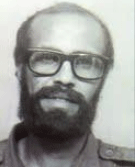Issays’s hypocrisy concerning Anti-Americanism and CIA.
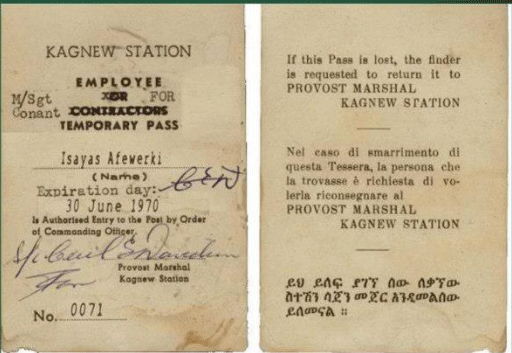
by Resoum Kidane 24/01/08
One of the political deceptions which the public should know about is Issays’s hypocritical anti-Americanism. The story of Issays’s connection with the CIA goes back to April 1970 and to the Kagnew, US. base, in Asmara.
Issays managed to keep this a secret for nearly 30 years, from 1971 to 2001, by covering up and systematically eliminating key figures who knew about the meeting between him and CIA at Kagnew Station. However, in the era of Internet nothing can be kept secret, and the true story has been published online by Hagos Woldu in 2003, Alem Tesfay in 2004, Woldeyesus Ammar in 2004, Oqabanquel Tesfatsion in 2007, Aida Kidane in 2007 and Ruth Habtemariam in 2008. In connection with this story, Alem Tesfay in 2004 explained the cause of Abrham Twoldeo death which is still secret, in the following words:
After Issays came back to the Ala groups from the meeting he held with members of the CIA, he decided to split from the ELF. Because of this there was an argument with Abrham Twoldeo who was against splitting from the ELF, and over the talks with the Americans and the Ethiopians. After one month of arguments between them Abrham Twoldeo died(1) suddenly on 17 May 1970, which is still a secret for most of us.” Concerning this Erlich (1988: 97), states that one of Issays's main rivals in the rebel movement was poisoned to death. After Abrham Twoldeo death, Issays succeeded to the leadership of the group and then he took steps to split from the ELF.
Regarding the story linking Issays and the CIA, most of the EPLF fighters who joined the Front in mid 1970s didn’t know about the secret meeting. And it would never have crossed their minds because there was a lot of campaigning against Imperialism and the CIA within the Front. The author of this paper still recalls when young students from Petogo in Asmara who joined the Front were accused of being CIA agents, and they were forced to confess in our presence that they were sent by the CIA. It was also intended to convince the new recruited fighters that the rumour disseminated by the ELF about the above meeting was groundless. It was designed by Issays to serve as an excuse for liquidating anyone who was a threat to his power during the period of the Menkaa movement. The Issays group spread the rumour that there were up to one hundred and fifty CIA agents within the movement (Megiesteab Kidane 2005:49). For example Tewelde Tesfamariam, who joined from Hamburg in 1972, was wrongly killed as a CIA spy.
It was Tesfamichael Giorgio who first broke the news about the Kagnew deal in the Eritrea Liberation Front. He also presented a paper at the Massawa Symposium ’Secessionists and CIA Connection’ in 1982. This paper is available for public reference from: www.ehrea.org/TesfaMikegiorgioAmarina.pdf. It gives full coverage to the entire story and should be recommended reading for everyone.
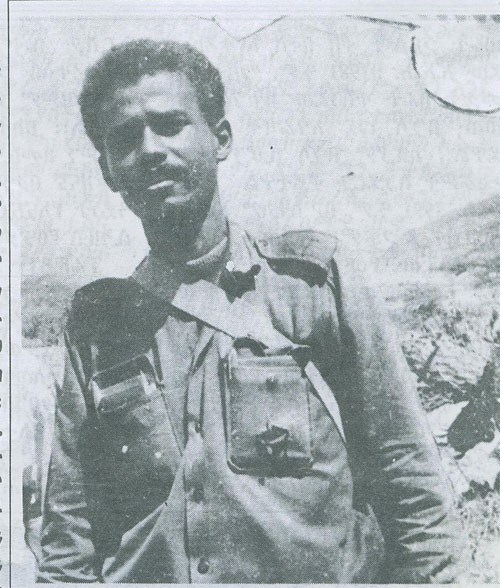
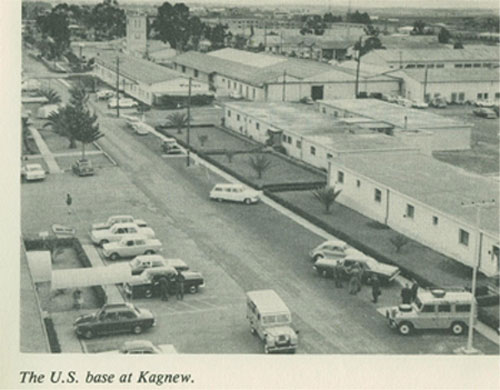
"At the end of the meeting, the negotiators went to Kagnew for dinner. Essayas and Wodi Giorgio spent the night at Copland's residence. The next day, Essayas and Wodi Giorgio were taken out of Kagnew Station in a Cadillac car driven by Copland himself, with curtains drawn, and flying the US flag". Excerpt from Revisiting the Kagnew Station Incident.Amar(2004)
Amar(2004) states that Wodi Giorg , who was at the meeting with Issays and Col. Mamuzer Copland on 2 July 1970(note), had an interview with the local press in Addis which appeared in an Amharic newspaper called "Senay", volume 1 number 3 of February 1993. A short while later, Wodi Giorgio was shot dead in front of his Addis Ababa house in order to keep the meeting secret.
Others who knew about the meeting at Kagnew Station, Habteselassie Ghebremedhin and Tweldeo Iyob were killed on the pretext of Menka; and Solomon Woldemariam and Haile Jebah also were killed on the pretext of the conflict with Yemen. The remaining founder of Self Nistnet who knew the story, namely Weldemichael Haile (note) was killed shortly after the victory of Segeneti in 1977 by an unidentified gunman. Tesfa Ytbark and Beraki were killed in the battlefield. The only survivor from the founders of Self Nitsnet was Asmerom, who has never wished to tell this secret to the public out of loyalty to Issays. Both Mesfin Hagos and Abdella Adem who were members of the Central Committee knew this story but since both collaborated with Issays in crimes against innocent fighters in the 1970s, I doubt that they will ever publicly tell the truth. Only Haile Menkeros, who taught foundation politics to the new recruits at Beleqet military training camp in 1975, when the fighters were accused of being CIA agents could inform the public. He was also Ambassador to Ethiopia in 1993 at the time when Tesfamichael Giorgio was assassinated by the EPLF security. He arranged to return the body of Tesfamichael from Addis Ababa to Asmara.
By and large, the Front systematically eliminated thousands of new recruits from among progressive Eritrean students under various pretexts in the 1970s., in contradiction to Issays’s proclaimed anti- Imperialism. This was well documented by historians and journalists who were experts in the Eritrean liberation struggle. According to Dan Connell (2003:271) in the 1970s. Issays insisted that American imperialism has been our enemy, is our enemy and will remain our enemy as long as it exists as an imperialist force in the world. Furthermore, in his 1984 interview with Adulis he also called the U.S an imperialist power which had exerted considerable pressure to destroy the Eritrean Revolution ( Adulis, 1984).
 The
Central Committee in session in 1984.(Adluis 1984)
The
Central Committee in session in 1984.(Adluis 1984)
But, unexpectedly he ceased to call the US an Imperialist power. An example of this was a 1986 interview in which he criticised the US policy in the Horn of Africa without calling the US either imperialist or an enemy of the Eritrea people. He simply claimed that “ a political solution to the Eritrean problem remained a secondary issue to the U.S. administration”(Levit, 1986). This occurred when he emerged as leader from the mid 1980s through eliminating his challengers (example Ibrahim Afa in 1985),
This was an attempt to revitalise his relationship with the USA which he had already established in 1970 . Indeed in the 1980s his relationship with the U.S improved, and he was invited for lunch with a senior member of the Bush Administration during the Atlanta meeting, 1989. Also he was invited to address a seminar at the Brookings Institution (Perlez 1990 ). Shortly after liberation, 1991, Issays chose to ally himself with the United States and Israel rather than have relations with liberation movements, despite this being in contradiction to what the EPLF had taught its members in the 1970s.This stance greatly contributed to enhancing his relations with the Bush Administration which had led to the opening of the Israel embassy on March 15, 1993. This followed Issays being flown to Israel for medical treatment in 1993 ( Muhammed, 2003)
 Issayas
Afeworki in Tel Aviv hospital 1993
Issayas
Afeworki in Tel Aviv hospital 1993
Throughout the 1990s America considered that “Issays was one of the new generation" of African leaders who could preserve the USA interests there, through protecting Israel’s regional security, and combating the extremist regime in Sudan. The first step by the Eritrean government was to accuse Turabi of helping the Jihad in Eritrea, Ittihad in Somalia, and the Oromos in Ethiopia.(The Middle East magazine, 1995) Consequently, the Islamist regime in Khartoum began to distance itself from Eritrea and in 1995, the tension between Khartoum and the Asmara government grew worse, leading to the closing of the Sudanese Embassy in Asmara.
In relation to the above, during Issays official visit to Washington in 1995, there was an agreement between Isaias Afeworki and Washington that the Eritrean military would be trained in US army camps This was in line with the aim to overthrow the Sudanese government. Ruth Simon (1997) reported that Eritrean soldiers fought alongside rebels in neighbouring Sudan. The escalation of tensions between the Sudanese and Eritrean governments served to strengthen U.S –Eritrean relations. On 4 May 1997, it was announced that the US was providing as much as $20 million in military supplies to the country (Timeline). This was due to the agreement reached between Issays Afework and Washington in 1995, and also to his great contribution in Laurent Kabila replacing Mobutu in Congo.
After a year of the military assistance from the USA, Issays, to ensure his hegemony in the region, ordered the Eritrea Defence Force to occupy Badema on 8 May 1998, which caused the Ethiopian –Eritrean 1998-2000 border war.
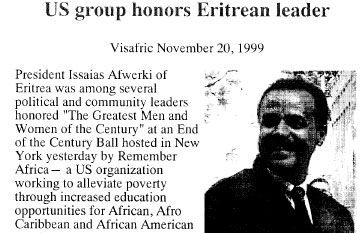
Despite the fact that Issays provoked the border conflict in May 1998, the following year he received honours from a US group for his leadership skills to end hunger, war and poverty (Visafrica, 1999). This was despite the fact that his conduct had opposed development, prosperity and peace by refusing to accept the U.S-Rwanda peace plan. He had rejected it on the grounds that Eritrea didn’t have to raise its hands in surrender, indicating that he was not willing to end the war through peaceful dialogue. Thereafter, in 2001 he accused a member of the national assembly, who wrote a letter to him advising that Eritrea should accept the U.S-Rwanda peace plan, of being recruited by the CIA, a cover up for his humiliating defeat in the 1998-2000 border war .

President Isaias Afewerki of Eritrea: CIA accused of 'coup plot' in Eritrea
Issays also accused the Central Intelligence Agency and the US envoy to Eritrea-Ethiopia, Anthony Lake, of plotting to overthrow him in 2000 (Gedab 2006) .Regardless of this accusation and the Government's poor human rights record which was reported by the State Department, in May 2002, National Security Adviser, Condoleezza Rice, made clear that, in the event that Eritrean extremists were to overthrow the regime, the US would be compelled to opt for the “lesser evil” and would defend Issays’s presidency in order to prevent the possibility of Eritrea becoming a menace to Israel( Mengesteab Kidane 2005: 181)
Furthermore, when the U.S. secretary of defence Donald Rumsfeld visited Eritrea in December, 2002 he was asked about Eritrea’s abysmal press freedom record. Instead of condemning Afeworki as one of Africa’s most brutal rulers, he answered: “it is a sovereign nation, and they arrange themselves and deal with their problems in ways that they feel are appropriate to them.” (News Transcript , 2002)

These two "pleasant" people are, from left to right, Donald Rumsfeld and Issays Afeworki, actual Eritrean dictator: they are shaking hands with great affection. ( source ).Rumsfeld: My goodness Mr. President I expected to hear some words from you.President: I will go right after you
Despite the fact that there had been little criticism from the US, in 2007 Issays tried again to divert the attention of the international community from his dictatorial rule and internal problems by portraying the US as the "historic enemy of Eritrea”. This contradicted what happened five years earlier when he had asked the US to set up a military base. Regarding this Kidane, Megisteab(2005:181) added that Issays’s offer to devote Eritrea’s scare resources to help America fight global terrorism, at a time when other countries in the region were working hard to use their geopolitical position as a leverage to squeeze more American aid, simply exposed Issays’s utter desperation to secure the regime preservation with U.S military patronage.
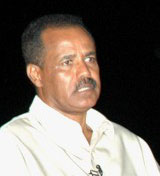 Eritrea
President Issayas Afewerki accused US again in 2007"A
plan initiated by the Washingtonadministration"
Eritrea
President Issayas Afewerki accused US again in 2007"A
plan initiated by the Washingtonadministration"
However, in 2007, only a year after he had tried to become a major ally in the US-led "war against terrorism", Issays made a u-turn, branding the US as the "historic enemy" of Eritrea, alleging it to be behind its conflict with Ethiopia,” (afrol News, 2008)
Regarding this Analysts stated: “Eritrea has in a matter of years gone from being a U.S. ally to a frontman for rival interests from Muslim north Africa and the Middle East” ( Kimbal, 2006)
The US-Eritrean relationship has deteriorated not because the Issays regime is a dictatorship but because the United States has supported Ethiopian intervention and helped the Somali interim government. On the other hand the Eritrean government supported the Islamist insurgents in Somalia, which was in contradiction to Issays’s earlier attitude toward Islamist extremism.
Issays has accused the US of an unjust and unfriendly policy in the Horn of Africa in 2007, he has never been a principled opponent of the U.S. In early 2008, during talks with US Congressman Donald Payne, he illustrated his hypocrisy by saying: “Eritrea wishes to improve its relations with the U.S"
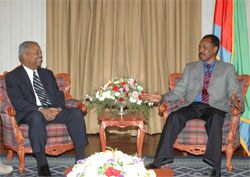
In general, his hypocrisy of being Anti-American has existed for the last 40 years, and includes branding the US as the "historic enemy of the Eritrean people to manipulate and divert Eritreans from thinking about justice and democracy and to get support from them when he planned to crush dissidents.
In fact he has betrayed the Eritrean people, more than anyone else since he has never wished to see a bright future for the younger generation of Eritrea. He has killed thousands of innocent young fighters under different pretexts accusing them of spying. His attitude towards the Eritrean people is no different from the former governor of Eritrea, Ras Asrate Kassa who said that he would leave Eritrea as bare as his bald head in 1967, just 40 years ago. Issays has still a desire for what he had in the mid-1990s to form a confederation between Eritrea and Ethiopia and to become the head of both states. Since he has this dream he has currently chosen to be allied with Kinjet (an Ethiopia opposition party which has never accepted the independence of Eritrea) in order to recreate a Greater Ethiopia.
In connection to his hypocrisy, the following questions should be raised:
1.Was the systematic purging of progressive fighters in 1970s related to the meeting between Issays and Col. Mamuzer. Copland on 2 July 1970?
One of the points in that meeting was Self Nitsnet (the new force which was founded by Issays after the death of Abrham Twoldeo who had been against the talks with the CIA at Kagnew Station) This organisation worked strongly against communist and socialist influences within the front. By the mid 1980s the front gradually abandoned its leftist outlook.
Issayas accomplished his task 10 years after his contact with the CIA in the 1980s through eliminating thousands of progressive intellectual fighters of the EPLF who had been Marxists. Issayas, was able to say in 1989: “ I don’t think there is even a trace of Leninst-style structure in the EPLF now “.(Perlez 1990)
To find information about those who were executed in the 1970s by the Front and mentioned by Mengeisteab Kidane(2005:50) please visit this web page.
2. Rumours were spread in the Menkaa movement, in the 1970s, accusing progressive fighters of being CIA recruits and this tactic was repeated in 2001. Why does Issays always accuse his challengers of being CIA agents ? Is he trying to cover up his 1970 secret meeting with the CIA?
3. How is one to explain the recent antagonistic relationship of Issays with the US? Is it going to develop a new anti-US relationship or is it mere demagogy.
In conclusion, the author appeals for the second time to all former members of the EPLF who survived the war, especially those who were in the Central Committee between 1977-1987 (Abdella Adem, Haile Menkerios, Mesfin Hagos and Andebrhan Wolde Giorgis ) and other senior post holders, especially members of the 72 ( the EPLF Intelligent Centre ) to tell the public the truth about the EPLF leadership’s crimes against innocent fighters. They should also break their silence about what they knew, concerning the conspiracy by Issays against the interest of the Eritrean people during their liberation struggle, and after liberation especiallyregarding to the proposal for the establishment of a confederation between Eritrea and Ethiopia and the development of relations between Israel and Eritrea. This had been a surprise for most EPLF fighters in 1993.
Note 1.
1.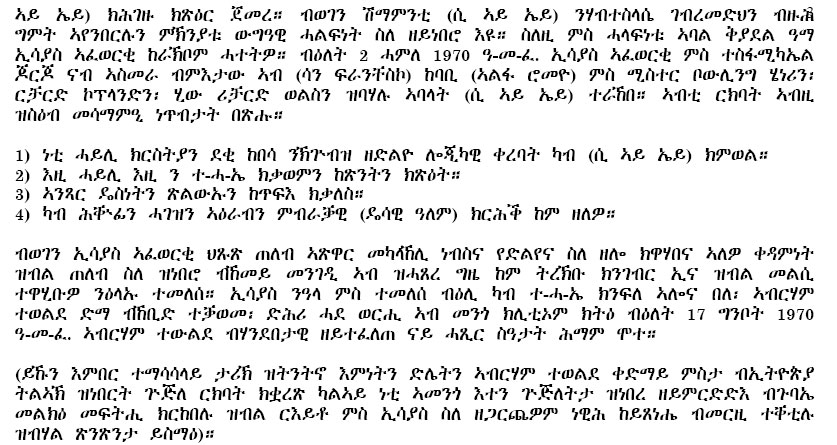
Excerpt from Kab Mezgeb Tarich by Alem Tesfay

INTERVIEW-Eritrean leader blames
CIA plot for youth exodus 13 May 2008 16:18:40
Brief summary: why does Issayas always accuse CIA?Is he trying to cover
up
his 1970 secret meeting with the CIA in Asmara ?
Category: General Comments
posted at 1:48:05 AM on 1/24/2008 -
eritrean wrote:
IMRA Newsletter
Israel to acquire two more German Submarines
Navy already operates three similar submarines, capable of launching cruise
missiles with nuclear warheads.
Maariv International
2004-12-22
http://www.maarivintl.com/i...
Germany has agreed to sell Israel another two Dolphin-class submarines, They will join the three Dolphin -class submarines already operated by the Israeli navy, making Israel one of the premier maritime powers in the Arabian Sea.
The new pair of submarines, like the first three, will be built at the Kiel-based Howaldtswerke-Deutsche Werft AG, the world's biggest builder of diesel submarines. The new boats are more advanced in that they will able to stay submerged for longer than the first Dolphins. The reported cost for the two craft is $700 million.
Berlin has overcome its reluctance to the craft being fitted with nuclear cruise missiles, in the interests of a newly adopted more aggressive defense exports policy, and out of understanding that the EU's attempts to halt Iran 's nuclear weapons program is unlikely to succeed.
Israel already has a major presence in the area. It has
a naval and air base at Dahlak, a small island owned by Eritrea just outside
the strategic Bab el Mandeb straits, where the Red Sea enters the Arabian
Sea. At least one of its three Dolphin submarines is always on patrol
in the Arabian Sea.....
1/24/2008 10:52:54 PM
Beadlu Haile wrote:
The only thing that is clear to me is that the U.S.A., Eritrea, and South
Africa are built and are found on CRIMINALS, from Europe, called Unwanted.these
criminals OUT-SMARTED the globe ,except ERITREA!!! good luck my country.
1/24/2008 9:06:13 PM
eritrean wrote:
Thursday 31 August 2006 (07 Sha`ban 1427)
How Israel Casts Its Dark Shadow Over Horn of AfricaMuhammed Salahuddin,
Arab News
After the Zionist attack on Lebanon, the Sanaa-based
Yemeni daily Al-Thawra published an interesting piece of information.
It said that Israel had transferred three warships from its military base
on Eritrea’s Dahlak Island on the Red Sea to support their military
operations against Lebanon. Official sources noted that Israel is creating
the biggest naval base outside Israel on the Dahlak Island. This followed
an agreement between Eritrea and Israel signed in 1995. Eritrea used Israeli
warships and huge logistical support from that naval base during its occupation
of the Yemeni Hunaish Island in 1996. The sources disclosed that Israel
has presence on two Eritrean islands: Dahlak and Fatma. The Israeli nuclear
wastes are accumulated in these islands. Israel also has monitoring centers
on the Red Sea to oversee the Kingdom of Saudi Arabia, Yemen, and Sudan
in addition to oil movements. The Eritrean Foreign Ministry refuted the
news item denying the existence of any Israeli base on their Islands.
However, an intensive study carried out by the Center for Political and
Strategic Studies and published by Al-Ahram in June 2006 titled “Isaias
Afewerki’s Regime and Developing Relations with Israel” confirmed
that the issue was much bigger than the Israeli military bases on Eritrean
soil. It revealed a strategic relationship between the two governments
that began with Eritrea’s President Isaias Afewerki traveling to
Israel for medical treatment in 1993. Afewerki was transferred to Israel
by an American airplane. The US representative in the Eritrean capital
Asmara was the one who suggested the idea after the Eritrean leader fell
ill. These happenings along with American efforts led to the opening of
an Israeli Embassy in Asmara in March 15, 1993 prior to the official announcement
on April 27, 1993. There also has been an inclusive agreement between
the two countries that was signed officially in March 1993 by Israel’s
Prime Minister Yitzhak Rabin and Eritrean President Afewerki. According
to the Center for Political and Strategic Studies’ report, Israel
has some clear motives for establishing and improving ties with Eritrea.
They wanted Eritrea to become the most important strategic ally to the
Zionist entity in every corner of the Horn of Africa and the Red Sea.
Their motives can be summed in two points: 1. The geostrategic importance
of the 360 Eritrean islands, especially Dahlak and Fatma islands. They
are located in the southern gateway of the Red Sea occupying some 1080
kilometers. The two islands have important features that affect the international
and regional naval balance. The two islands can also be used for stationing
marine and land forces and for monitoring all naval activities in the
region. Israel thought that by controlling these islands it can avoid
any Arab attempts to impose a naval blockade on Israel under any circumstances.
Israel’s presence on the islands will also stop the Red Sea from
turning into Arab waters. 2. Another advantage is the importance of Eritrea’s
location in serving the Israeli strategies in motoring and spying on Saudi
Arabia, Yemen, and Sudan. The three countries are not Israel’s allies.
In 1998, the British “Foreign Report” bulletin, specializing
in intelligence affairs, reported that Israel maintains close intelligence
relations with Ethiopia and Eritrea, and that the Israeli spy agency Mossad
has established in the Ethiopian capital, Addis Ababa, a center for gathering
intelligence information.According to the British weekly, Eritrea permits
Israel to carry out vast activities on Dahlak Island on the Red Sea. Because
of the presence of the Israelis on this island, the Mossad can carry out
monitoring operations and collect important information about Yemen and
Saudi Arabia. The Foreign Report bulletin also stated that the Mossad
has a very active intelligence gathering station not far from Eritrea’s
borders with Sudan.
1/24/2008 3:31:09 PM
eritrean wrote:
Isayas was not only X-CIA agent, until 1998 he was X-Mossad Agent. Until
1998 were Israel-Marine in Massawa with middle-range Atombomb (U-Boat),
to attack Iran.
1/24/2008 1:57:13 PM
Add Comments
References
Adulis (1984) Adulis (Vol. 1 No 4-5, 19 pages)October-November
1984
http://www.ifaanet.org/politicsaf/Greater/Adulis.doc
afrol News (2008)Humiliated Eritrea blames US for Somali war
http://www.afrol.com/articles/23535
Allafrica( 2007) Eritrea: People's Support to Somali
People is Consistent And Historical
http://allafrica.com/stories/200709150068.html
Amar, Woldeyesus (2003)Revisiting the Kagnew Station
Incidience
http://www.ehrea.org/iscia.htm
Connell, Dan (2003) Taking on the Superpowers: collected articles on the Eritrean Revolution (1976-1982) vol.1
Erlich,(1988). Eritrea in the Western Media.
Compiled by concerned Americans and Eritreans of the San Francisco Bay
Area.
Gedab (2006) Eritrea-US Relationship Deteriorates To
New Lows
http://www.awate.com/artman/publish/article_4507.shtml
HornAfrica (2008) President Isaias holds talks with US Congressman Donald Paynehttp://www.hornofafrica.de/english/2007_eng/03_mar_2007/04january_eritrea.htm
Kimbal, Jack(2006) Eritrea sends envoy to open ties with
Iran
http://www.alertnet.org/thenews/newsdesk/L15504281.ht
Levit, Stephen (1986) Interview with Issayas Afeworki
Vice-Secretary General EPLF
http://www.ifaanet.org/politicsaf/Greater/asena%20-%20INTERVIEW%20WITH%20ISSAYAS%20AFEWORKI%20-%201986.htm
Mengisteab, Kidane and Yohannes, Okbazghi (2005)
Anatomy of an African tragedy: Political, Economic and Foreign Policy
crisis in Post-Independent
News Transcript (2002)Secretary Rumsfeld Press Availability In Eritrea
you.http://www.defenselink.mil/transcripts/transcript.aspx?transcriptid=2855
Salahuddin, Muhammed(2003) How Israel Casts Its Dark
Shadow Over Horn of Africa
http://www.deqebat.com/pdf006/Dahlack_Eri_Isreal_01.pdf
Tesfay, Alem (2004) Kab_Mezgeb_Tarich
http://www.ehrea.org/Kab_Mezgeb_Tarich_2004.pdf
The Middle East magazine(1995) Asmara Khartoum, Hostility
in the Horn
http://chris-kutschera.com/A/Asmara%20Khartoum.htmCHRIS
Timeline Eritrea
http://timelines.ws/countries/ERITREA.HTML
Perlez, Jane(1990) Africa's 30 Years' War: A Rebel Scouts
for Allies
Sheeb Journal
http://www.ifaanet.org/politicsaf/Greater/Sheeb%20Journal.htm
Visafrica (1999) U.S group honors Eritrean leader
http://www.ehrea.org/23rdJanLibrary.PDF
